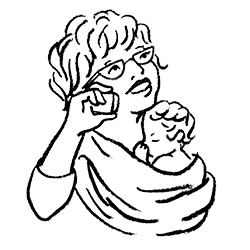COMMON CONDITIONS
Treating Mastitis
test
summary
Mastitis is a common problem for nursing parents that may be characterized by firm, painful areas in the breasts; uncomfortable or tender breasts; redness of the breast skin; and fever or flu-like symptoms. We now talk about mastitis as a spectrum of issues, ranging from inflammation in the ductal tissue to bacterial infection to breast abscess. Mastitis symptoms will often resolve with simple management techniques, such as those described below, along with support from your care team.
A good understanding of how the breasts make milk can help prevent mastitis and manage overall breast health. There is no need to empty the breasts to prevent “clogs” or infection. When you do not remove milk, your body does not receive the signals it needs to make more milk, and it will simply stop making milk. You may experience a temporary increase in discomfort; such discomfort can be alleviated with the strategies described below.
Furthermore, you can feel reassured that an infection cannot develop in a few hours or even overnight. When you wake up in the morning with tenderness and redness of your breasts after a long stretch of sleep, this is usually from swelling, fluid retention, and inflammation. Normal lactating breasts may fluctuate in how they look and feel over the course of a day and over the course of time you are providing milk for your baby. They may sometimes feel lumpy or even tender or painful. Finally, a fever and flu-like symptoms may be hormonal and are not always due to an infection. Normal postpartum hormonal shifts can cause night sweats and symptoms that resemble a fever. A lactation consultant as well as your OB or midwife can answer any questions you may have about possible mastitis symptoms and help you with a treatment plan for mastitis.
Equipment Needed:
- Breast pump (optional)
- Ice
- NSAIDs (ibuprofen, acetaminophen)
Steps:
- Feed your baby and/or pump your breasts as you normally would. There is no need to empty the breasts more often to treat mastitis. Your lactation consultant can help establish a feeding/pumping schedule, especially if you have an oversupply and need to reduce milk production.
- Limit pumping. If you are pumping because there is a medical need, or if you are exclusively pumping, pump at a frequency and volume most like normal breastfeeding. More frequent or lengthy pumping sessions can increase ductal inflammation and worsen mastitis symptoms.
- If your breasts are full and uncomfortable, you can hand express a small amount of milk. Instructions for hand expression are below. You can also pump for two or three minutes until the breasts are more comfortable.
- Apply ice to decrease inflammation and fluid retention as well as to treat mastitis symptoms. You can ice once an hour or more often, as desired. Protect your skin from damage from ice by using a cloth barrier.
- NSAIDs such as ibuprofen and acetaminophen may be used to treat inflammation and ease discomfort.
- Consult with your OB or midwife about taking 5-10g of sunflower lecithin a day to reduce inflammation.
- Use only light, gentle massage to the breasts. Avoid deep massage as this can bruise the tissue causing further damage.
- Wear a well fitting, supportive bra as mild compression is beneficial to inflammation.
Follow Up:
Please call if signs or symptoms of worsening inflammation or mastitis develop including breast pain, fever, body aches, and chills.
Resources:
This and other how-to guides are available as free downloads

